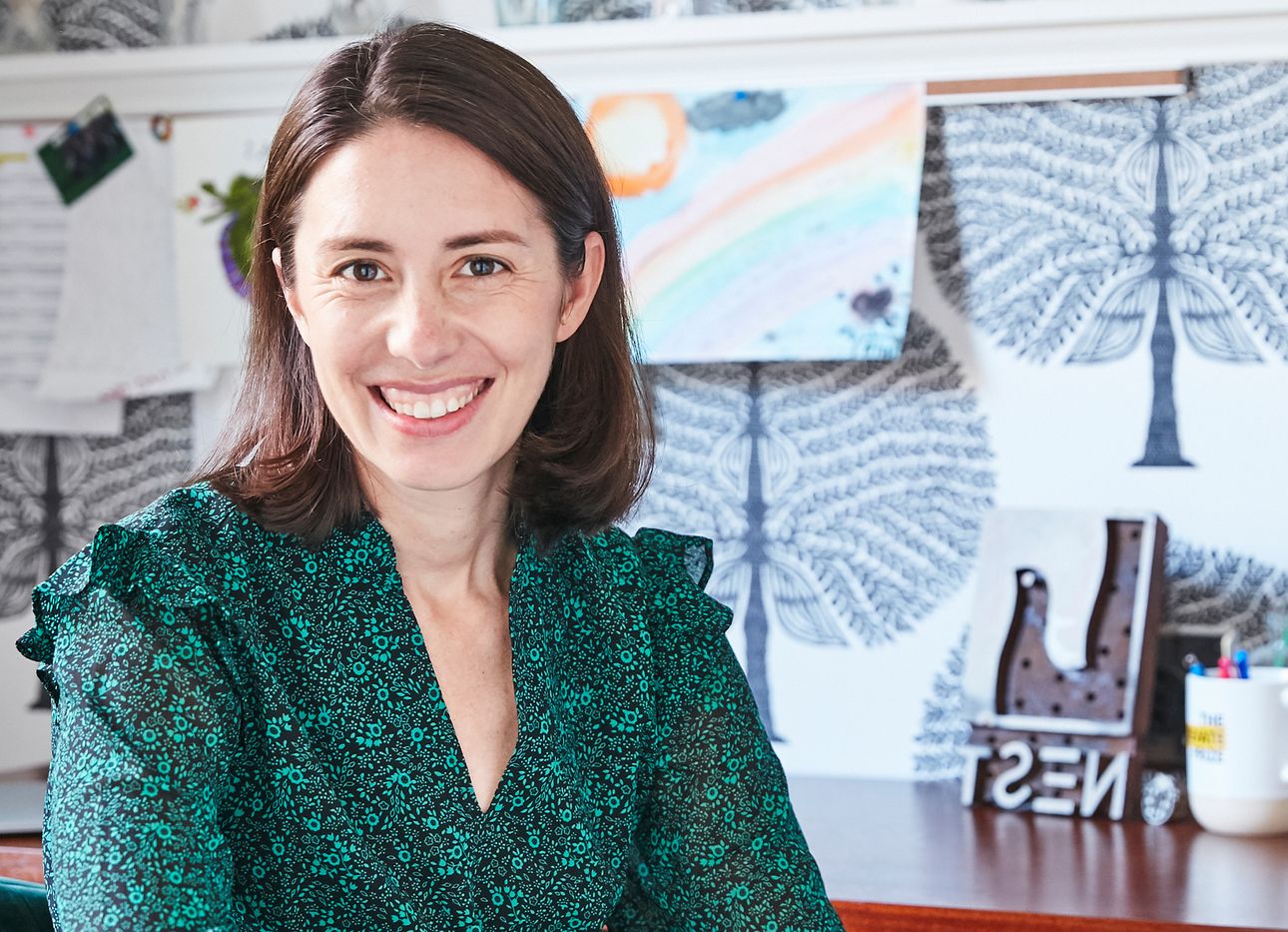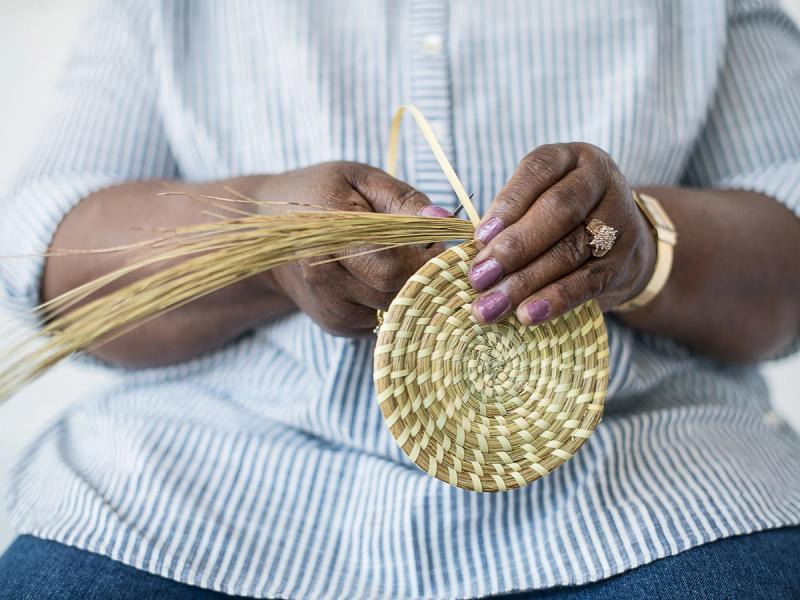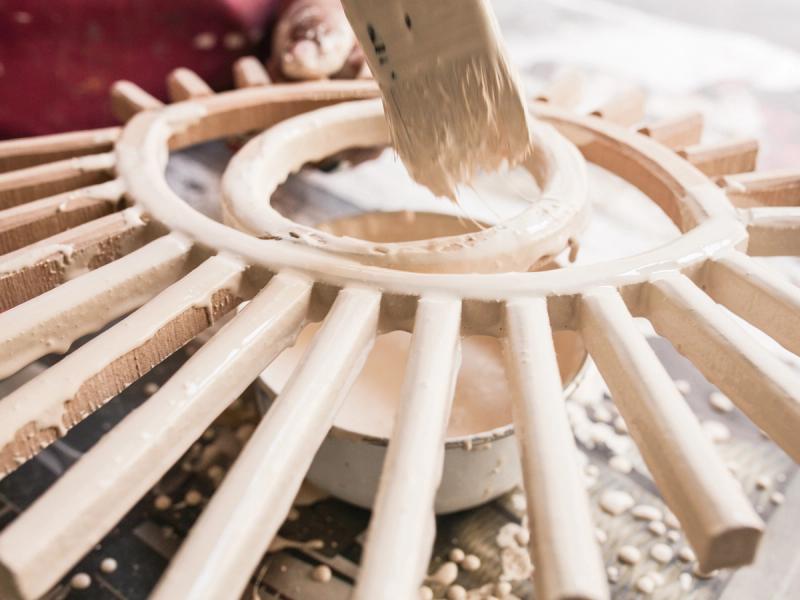
For Rebecca van Bergen, Craft Is a Means to Change the World
For the past 16 years, Rebecca van Bergen has been laying the groundwork for a more equitable, inclusive, and transparent environment for those in the business of artisan handwork. For her, “equitable,” “inclusive,” and “transparent” aren’t marketing-speak hype-words; she means them in their truest sense, as paths toward greater economic power.
As the founder and executive director of the nonprofit Nest, van Bergen has woven together a potent platform for change. Its name is as clever as it is befitting. The notion of building a nest—a protected place of birth, care, support, and growth—is indeed the very embodiment of her organization’s ethos. From the start, Nest has sought to forge a resilient handworker economy. Not only has Nest pioneered “micro-bartering” (in which artisans receive loans they pay back in the form of product), it has also built a 1,600-plus-member guild of craft-based businesses (spanning 120 countries, it comprises an 88 percent female workforce); created a set of now widely adopted handworker protection standards; and partnered with brands including West Elm, Patagonia, and Eileen Fisher on things such as production compliance, responsible sourcing, and connecting designers and craftspeople. This is just to name a few of the fruits of van Bergen’s labor. The pandemic has seen engagement skyrocket: Between 2020 and 2021 alone, Nest saw its guild grow by 84 percent.
This week, in partnership with Hermès, as part of the French luxury house’s “Hermès in the Making” exhibition in Troy, Michigan (open to the public from June 10–15), van Bergen will lead conversations on the subjects of repair and regeneration, and also launch a program for Detroit-based makers. Here, we speak with van Bergen about the pandemic-led rise of home-based work, the links between craft and activism, and Detroit’s maker legacy.

How did you first arrive at the idea for Nest?
I got my degree in social work, and at the time that I graduated Muhammad Yunus had just won the Nobel Peace Prize for microfinance. Globally, people were scaling this idea of investing in micro-entrepreneurship. That seemed intriguing, but in our country, a loan is debt. It’s not necessarily a successful business. I was interested in creating a model that offers more holistic support—for women, primarily—and recognizes that making and craft are cornerstones of employment for women in our country and around the world.
Craft is a vehicle for economic opportunity, but it’s also culture- and community-building. It ties it back to nature and place, and is healing. At Nest, we also spend a lot of time thinking and talking about the healing properties of craft. We’re currently working with displaced Ukrainian refugees, and with other very vulnerable populations. Making is a really important element of their healing from trauma.
What major shifts have you seen within these artisan communities over the past decade, and particularly more recently, during the pandemic?
One of the things we’ve been excited about is that artisan making is often home-based. For a long time, that wasn’t necessarily seen as a positive by global supply chains or individuals. Then we all became home-based workers during Covid. There has been a new appreciation for the resilience and importance of women being able to work from home.
People have had more time at home on computers, too. We’ve seen a surge of people paying attention to how they shop because they weren’t just going to a local big-box store to pick up things. They had more time to research and compare things and learn.
In the U.S., there has also been a really important, very, very long overdue call to action around racism and diversity and equity. A lot of the work we do is giving under-voiced makers, artists, and cultural traditions here a platform, and opportunities that they might not have had otherwise.
When I spoke with the craft scholar and historian Glenn Adamson on The Slowdown’s Time Sensitive podcast last year, he told me, “When you tell the story of American craft, you’re largely telling the story of Black, Native American, and other ethnic minorities, of women, and of course, of the white working class.” Could you elaborate on this history? As you noted, the majority of artisans are women. How does this shape the work you do?
I love Glenn’s book [Craft: An American History], so I’m glad you interviewed him. He’s spot-on.
There are several answers I have to that. The first is that, because so much of craft is done by Black communities, Native communities, and women, I’m interested in how we decide what is “craft” and what is “art.” A lot of craft has been deemed “craft” because it’s by those populations, and maybe not by white men. That’s a really important call-out as we think about craft. Often, when you’re using the word craft, it can be a belittling term. I really love—and Nest feels really strongly about—trying to change the narrative around craft and what it means.
In Glenn’s book—actually, in a lot of his research—there’s this really interesting dynamic between craft and activism—
Craftivism.
Because it’s by these communities where they face systemic challenges. Craftspeople are, by nature, creative and innovative, so very often there’s this dynamic between craft movements and activism, worker protections, investing in women—
Pink Pussyhats.
Exactly. Or the AIDS quilt. There are so many examples.

Along the way, you’ve created the Nest Ethical Handcraft Program, which combines more than a hundred standards to determine things like safe working environments, fair wages, and representation. What’s your aim for this?
Just because something is handmade doesn’t mean it’s ethical. Part of what we’re trying to do is help put together a repeatable, adoptable set of standards and processes so that companies can make sure that artisans are being paid fairly and working in safe conditions, even if it’s their homes. Most craft is paid per piece. So you’re paying per basket, per quilt, per panel—not a salaried wage. It’s extremely common for there to be drastic underpayment in the artisan sector.
Could you speak to the role of human touch, and the fact that these jobs are really about the vast possibilities of the human hand?
That’s at the core of all we do. We work with textiles and clay and a whole bunch of beading and leathers. It all comes back to human interaction with the medium.
I’m often asked about robotics and technology and the future, and whether handcraft is dying. It’s been interesting to see that the more automated our world becomes, the bigger the handcraft market has become. They’re actually happening in parallel. I think that’s because there’s a pendulum. People don’t want an entirely automated world. The more so many aspects of our daily lives become technological, the more we crave and want handcrafted goods—whether that’s food, what we wear, or gifts.
How are you thinking about craftwork in relation to scale? Is there even such a thing, when it comes to craft and making, as “too big”?
We have our Artisan Guild, which is a global network of artisan businesses. I was speaking to one of our makers in Detroit last week on the phone, and he’s making leather in his basement. He has a beautiful workshop, but it’s just him at home. We also have a dispersed artisan business in the Philippines that has two thousand women all working in their different homes across various islands. They’re this massive cottage industry, and they’re making baskets at scale. Each of those examples is great. There’s a place in the world for both.
We try to stay fairly broad in how we view the craft sector. We realize that there’s a place for extraordinary luxury mastercraftsmen preserving cultural traditions, and then there’s also value in democratizing handcraft, and being able to produce things still handmade and still ethically made, but at a slightly larger scale and at a slightly more accessible price point. We want to be able to help both of those enterprises, since handcraft and equitable employment are at their heart.

Let’s talk localism. In terms of the American handcraft landscape in particular, what potential for it do you see at the local level?
So much. The maker movement in the U.S. has been booming, and Covid spurred it forward. People now see opportunity and/or have rethought their priorities and values. We’ve had several makers join our programs that used to have full-time employment. Now they want the flexibility to be home, so they’re willing to make some trade-offs and invest in craft.
Another thing, still, is that we haven’t fully appreciated some of the cultural traditions that already exist in the United States. One of our major efforts for the last several years has been finding and working with pockets of American craft that have been underinvested in. We have a project in Gee’s Bend, Alabama, which is between Birmingham and Selma. The whole community came from a plantation, and after emancipation, the [formerly enslaved] stayed. Actually, much of the community still carries the surname Pettway, because it was the Pettway plantation. They make the most incredible quilts you’ve ever seen. They have a postage stamp. And yet, the community doesn’t consistently have access to plumbing and electricity. It’s more or less a food desert. There have been voting-rights issues. Their annual income, I think, was about sixteen thousand dollars a year, despite having this incredible culture and history so entrenched.
We’ve been working to bring communities like that online so that they can sell directly to consumers. We’ve seen outstanding returns in Gee’s Bend. I believe they’ve had a five times increase in monthly wages since they’ve been able to sell directly.
How do you see Detroit fitting into this conversation? I mean, Detroit, of course, has this big craft history, particularly around automotive manufacturing, engineering, and design.
We now think of craft more as baskets or candles, but it really has this long history coming out of the trades. A lot of that was in Detroit. Welding. Leather manufacturing. There’s this deep-rooted connection to both craftsmanship and the trades in Detroit that is really powerful. But Detroit also went into the world of automation, and is not necessarily akin to worker-led movements. There’s now this really amazing opportunity to redefine Detroit by a maker movement, by bringing back some of these skills, but in a way that’s owned and led by makers.

And isn’t just marketing.
Exactly. We launched our Makers United program in Detroit several years ago and have been helping map a more diverse maker movement there, investing in business-development support for the micro-entrepreneurs there. In parallel to Hermès’s “In the Making,” we’ll be launching a program with Hermès to work with Detroit makers.
Tell me a bit about talks you’ll be facilitating around “Hermès in the Making.” What do you plan to discuss?
The talks will focus on repair and regeneration, which we haven’t touched on yet in our conversation. Hermès has always considered the longevity of their goods to be one of the most important elements of craftsmanship. Being able to repair them is a piece of their longevity, in ensuring that they’re heirlooms. We always think of craftsmanship as being the creation of new things, but in our age of overconsumption, thinking of craftsmen as repairmen and repairwomen is really exciting to me. We don’t always have to be producing new things. We could actually keep our entire world of craftswomen employed by repairing and keeping a longer life on goods that they make, or that others make.
I like to say that more people should be thinking about how we can kintsugi our culture.
Exactly. One of the things I love about Hermès is that their repairmen are actually their longest-trained craftspeople. You have to be at the pinnacle of your career to repair things [at Hermès], because you have to know so fully how to make the good in order to be able to repair it. That’s such a beautiful representation of where we should be thinking and heading as consumers. Sustaining the life of our goods should be the goal. We should invest in that.